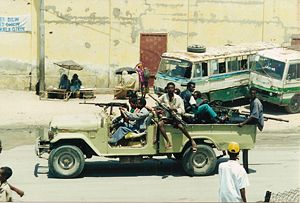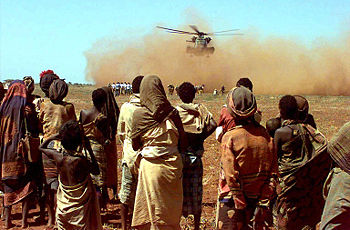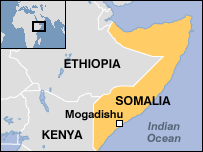Home »
Historical Background
Background: Britain withdrew from British Somaliland in 1960 to allow its protectorate to join with Italian Somaliland and form the new nation of Somalia .
In 1969, a coup headed by Mohamed SIAD Barre ushered in an authoritarian socialist rule that managed to impose a degree of stability in the country for a couple of decades. After the regime's collapse early in 1991, Somalia descended into turmoil, factional fighting, and anarchy.
In May 1991, northern clans declared an independent Republic of Somaliland that now includes the administrative regions of Awdal, Woqooyi Galbeed, Togdheer, Sanaag, and Sool. Although not recognized by any government, this entity has maintained a stable existence and continues efforts to establish a constitutional democracy, including holding municipal, parliamentary, and presidential elections.
The regions of Bari , Nugaal, and northern Mudug comprise a neighbouring self-declared autonomous state of Puntland, which has been self-governing since 1998 but does not aim at independence; it has also made strides toward reconstructing a legitimate, representative government but has suffered some civil strife.
Puntland disputes its border with Somaliland as it also claims portions of eastern Sool and Sanaag. Beginning in 1993, a two-year UN humanitarian effort (primarily in the south) was able to alleviate famine conditions, but when the UN withdrew in 1995, having suffered significant casualties, order still had not been restored.
A two-year peace process, led by the Government of Kenya under the auspices of the Intergovernmental Authority on Development (IGAD), concluded in October 2004 with the election of Abdullah YUSUF Ahmed as President of the Transitional Federal Government (TFG) of Somalia and the formation of an interim government, known as the Somalia Transitional Federal Institutions (TFIs).
The Somalia TFIs include a 275-member parliamentary body, known as the Transitional Federal Assembly (TFA), a transitional Prime Minister, Nur "Adde" Hassan HUSSEIN, and a 90-member cabinet.
The TFIs are based on the Transitional Federal Charter, which outlines a five-year mandate leading to the establishment of a new Somali constitution and a transition to a representative government following national elections.
While its institutions remain weak, the TFG continues to reach out to Somali stakeholders and work with international donors to help build the governance capacity of the TFIs and work towards national elections in 2009. In June 2006, a loose coalition of clerics, business leaders, and court's militias defeated powerful Mogadishu warlords and took control of the capital.
The Courts continued to expand militarily throughout much of southern Somalia and threatened to overthrow the TFG in Baidoa. Ethiopian and TFG forces, concerned over links between some Court's Union factions and the operatives responsible for the bombings of the US embassies in Tanzania and Kenya in 1998, intervened in late December 2006, resulting in the collapse of the Court's union as an organization. However, the TFG continues to face violent resistance from insurgents.
Somali Civil War
 Technical in Mogadishu |
||
| Casualties and losses | ||
| Date: | 1988 – Current | |
Casualties:
300,000 - 400,000 dead
The Somali Civil War is an armed conflict in Somalia that started in 1988.
Contents
1 Downfall of Siad Barre (1986–1992)
2 UN Intervention (1992–1995)
3 Division of Somalia (1998-2006)
4 Rise of the ICU, War with the ARPCT, TFG and Ethiopia (2006–present)
4.1 Height of CU power
4.2 Ethiopian intervention and collapse of the ICU
4.3 US intervention
4.4 Insurgency and reappearance of inter-clan fighting.
Downfall of Siad Barre (1986–1992)
The first phase of the civil war stemmed from the insurrections against the repressive regime of Siad Barre. After his ousting from power, a counter-revolution took place to attempt to reinstate him as leader of the country.
The increasingly violent and chaotic situation evolved to a humanitarian crisis and to a state of anarchy.
In 1991, to insulate it from the more violent fighting in the south, the Republic of Somaliland declared itself independent, though it was not formally recognized as such by the international community. It comprises the northwestern section of the country (between Djibouti and the northeastern area known as Puntland).
UN Intervention (1992–1995) UNOSOM I, UNITAF, and UNOSOM II UN Security Council Resolution 733 and UN Security Council Resolution 746 led to the creation of UNOSOM I, the first mission to provide humanitarian relief and help restore order in Somalia after the dissolution of its central government.
UN Security Council Resolution 794 was unanimously passed on December 3, 1992, which approved a coalition of United Nations peacekeepers led by the United States to
form UNITAF, tasked with ensuring humanitarian aid being distributed and peace being established in Somalia .
The UN humanitarian troops landed in 1993 and started a two-year effort (primarily in the south) to alleviate famine conditions.

Somalis and Australian Army soldiers wait near the loading zone of a US Marine CH-53 Sea Stallion delivering Australian wheat
Critics of US involvement pointed out that "just before pro-U.S. President Mohamed Siad Barre was overthrown in 1991, nearly two-thirds of the country's territory had been granted as oil concessions to Conoco, Amoco, Chevron and Phillips.
Conoco even lent its Mogadishu corporate compound to the U.S. embassy a few days before the Marines landed, with the first Bush administration's special envoy using it as his temporary headquarters.
" The cynical assertion was that, rather than a purely humanitarian gesture, the US was stepping in to gain control of oil concessions. Somalia has no proven reserves of oil, but there is considered to be possible reserves off Puntland. Even today, oil exploration remains a controversy.
The Transitional Federal Government has warned investors to not make deals until stability is once again brought to the country.
For many reasons not least of which were concerns of imperialism, Somalis opposed the foreign presence.
At first, the Somali people were happy about the rations the UN and U.S. troops brought them but soon came to believe that the latter were out to convert them from their religion. Some to have been introduced by the warlord thinks this idea Mohamed Farah Aidid.
In the period between June and October, several gun battles in Mogadishu between local gunmen and peacekeepers resulted in the death of 24 Pakistanis and 19 US soldiers (total US deaths were 31), most of who were killed in the Battle of Mogadishu. 1000 Somali militia was killed in that battle.
The incident later became the basis for the book and movie: Black Hawk Down. The UN withdrew on March 3, 1995, having suffered more significant casualties. Order in Somalia still had not been restored.
Division of Somalia (1998-2006)
Consolidation of States within Somalia (1998-2006) and Attempts at Reconciliation in Somalia (1991-2004)
The period of 1998–2006 saw the declaration of a number of self-declared autonomous
states within Somalia . Unlike Somaliland , they were all movements of autonomy, but not outright claims of independence.
The self-proclaimed state of Puntland declared "temporary" independence in 1998, with the intention that it would participate in any Somali reconciliation to form a new central government.
A second movement occurred in 1998 with the declaration of the state of Jubaland in the south.
A third self-proclaimed entity led by the Rahanweyn Resistance Army (RRA) was set up in 1999, along the lines of the Puntland. That "temporary" secession was reasserted in 2002. This led to the autonomy of Southwestern Somalia . The RRA had originally set up an autonomous administration over the Bay and Bakool regions of south and central Somalia in 1999. The territory of Jubaland was declared as encompassed by the state of Southwestern Somalia and its status is unclear.
A fourth self-declared state was formed as Galmudug in 2006 in response to the growing power of the Courts Union. Somaliland is also seen as an autonomous state by many Somalis even though its natives go another step in pronouncing full independence.
Also during this period, various attempts at reconciliation met with lesser or greater measures of success. Movements such as the pan-tribal Transitional National Government (TNG) and the Somalia Reconciliation and Restoration Council (SRRC) eventually led to the foundation, in November 2004, of the Transitional Federal Government (TFG). However, warlord and clan-based violence continued throughout the period and the so-called national government movements had little control over the country at the time.
Rise of the ICU, War with the ARPCT, TFG and Ethiopia (2006–present)
Somali Civil War (2006-present), War in Somalia (2006–present), Transitional Federal Government, ARPCT, and Islamic Courts Union In 2004, the Transitional Federal Government (TFG) was founded in Nairobi , Kenya .
Matters were still too chaotic inside Somalia to convene in Mogadishu . In early 2006, the TFG moved to establish a temporary seat of government in Baidoa.
During the early part of 2006, the Alliance for the Restoration of Peace and Counter-Terrorism (ARPCT) was formed as an alliance of mostly-secular Mogadishu-based warlords.
They were opposed to the rise of the Courts Union, which had been rapidly consolidating power. They were backed by funding from the US CIA. This led to increasing conflict in the capital.
Height of ICU power
Second Battle of Mogadishu and Battle of Baidoa
By June 2006, the ICU succeeded in capturing the capital, Mogadishu , in the Second Battle of Mogadishu. They drove the ARPCT out of Mogadishu , and succeeded in persuading or forcing other warlords to join their faction. Their power base grew as they expanded to the borders of Puntland and took over southern and middle Jubaland.
The Islamic movement's growing power base and militancy led to increasingly open warfare between the them and the other factions of Somalia, including the Transitional Federal Government (TFG), Puntland and Galmudug, the latter of which formed as an autonomous state specifically to resist the Islamic court. It also caused the intervention of Ethiopia , who supported the secular forces of Somalia .
The CU allegedly obtained the support of Ethiopia 's rival, Eritrea and foreign fighters, and declared Holly War against Ethiopia in response to its occupation of Gedo and deployment around Baidoa.
Ethiopian intervention and collapse of the ICU
Battle of Bandiradley, Battle of Beledweyne, Battle of Jowhar, and fall of Mogadishu
In December 2006, the ICU and TFG began the Battle of Baidoa. Fighting also broke out around the Somali town of Bandiradley in Mudug and Beledweyn in Hiran region.
The Courts union aimed to force the Ethiopians off Somali soil. However, they were defeated in all major battles and forced to withdraw to Mogadishu . After the brief final action at the Battle of Jowhar on December 27, the leaders of the Courts union resigned.
Battle of Jilib and fall of Kismayo
Following the Battle of Jilib, fought December 31, 2006, Kismayo fell to the TFG and Ethiopian forces, on January 1, 2007. Prime Minister Ali Mohammed Gedi called for the country to begin disarming.
US intervention
Battle of Ras Kamboni
In January 2007, the United States officially militarily interceded in the country for the first time since the UN deployment of the 1990s by conducting air strikes using AC-130 gun ships against Islamic insurgents in Ras Kamboni, as part of efforts to catch or kill operatives supposedly embedded within Courts union forces. Unconfirmed reports also stated US advisors had been on the ground with Ethiopian and Somali forces since the beginning of the war. Naval forces were also deployed offshore to prevent escape by sea, and the border to Kenya was closed.
Islamic insurgency and reappearance of inter-clan fighting
Islamic insurgency in Somalia (2007-Present) and African Union Mission to Somalia
No sooner had the Courts union been routed from the battlefield than their troops disbursed to begin a guerrilla war against Ethiopian and Somali government forces. Simultaneously, the end of the war was followed by a continuation of existing tribal conflicts.
To help establish security, a proposed African Union Mission to Somalia (AMISOM) was authorized to deploy as many as 8,000 peacekeepers to the country. This mission widened the scope of countries that could participate over the earlier proposed mission led by the Horn of Africa-based nations of IGAD. The group leading the insurgency opposes the presence of foreign troops.
On 7 December, the UN Security Council voted to authorize an 8,000-strong peacekeeping mission built from the forces of members of the Intergovernmental Authority on Development (IGAD). IGAD's seven members are Djibouti , Eritrea , Ethiopia , Kenya , Somalia , Sudan , and Uganda .
The makeup of IGAD, whose members support both sides, was expected to make an actual mission difficult. The resolution also eased a 1992 arms embargo against the Somali government.
Since 1991, some sources 350,000-1,000,000 Somalis have died because of the conflict.



